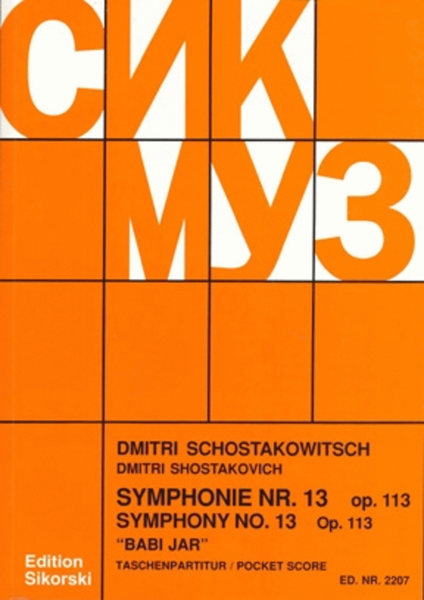Symphony No. 13, Op. 113 (Babi Yar)
Study Score
Details
Description
SKU: HL.50480403
Study Score. Composed by Dmitri Shostakovich. Study Score. Classical, Contemporary, Russian, Symphony. 232 pages. Sikorski #SIK2207. Published by Sikorski (HL.50480403).UPC: 073999793697. 6.0x8.25x0.666 inches.
The Symphony No. 13 in B flat minor (Op. 113, subtitled Babi Yar) by Dmitri Shostakovich was first performed in Moscow on December 18, 1962 by the Moscow Philharmonic Orchestra and the basses of the Republican State and Gnessin Institute Choirs, under Kirill Kondrashin (after Yevgeny Mravinsky refused to conduct the work). The soloist was Vitali Gromadsky.The work has five movements: 1. Adagio (Babi Yar) 2. Allegretto (Humour) 3. Adagio (In The Store) 4. Largo (Fears) 5. Allegretto (A Career)The work sets poems by Yevgeny Yevtushenko on the World War II Babi Yar massacre and other topics. The first poem, Babi Yar, criticises Soviet anti-Semitism and official indifference to the Holocaust. The second, "Humour", personifies humor as a mischievous rascal who constantly eludes official attempts at censorship and silencing. The third, "In the Store", is an ode to the hard-working women of the Soviet Union, always tired from standing in long lines at the store, often in bitter cold. The fourth, "Fears", recalls the pervasive atmosphere of dread during the Stalin era, and the final poem, "A Career", is a celebration of Galileo's refusal to recant his discoveries about the nature of the heavens, even in the face of censorship and threats from the authorities.The symphony was completed during a thaw in Soviet censorship, but even so Nikita Khrushchev criticised it before the premiere, and threatened to stop its performance. The premiere went ahead, but afterwards Yevtushenko was forced to change his poem, replacing a stanza declaring in part "I am every old man shot dead here, I am every child shot dead here" with a stanza mourning the ethnic Russians and Ukrainians that died alongside the Jews at Babi Yar. Thereafter the work was infrequently performed until more recently.Shostakovich originally intended the first movement to stand by itself, but ideas kept coming to him and he had to expand the work into its current symphonic form.

 Share
Share